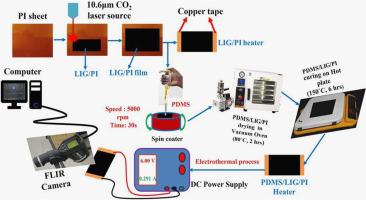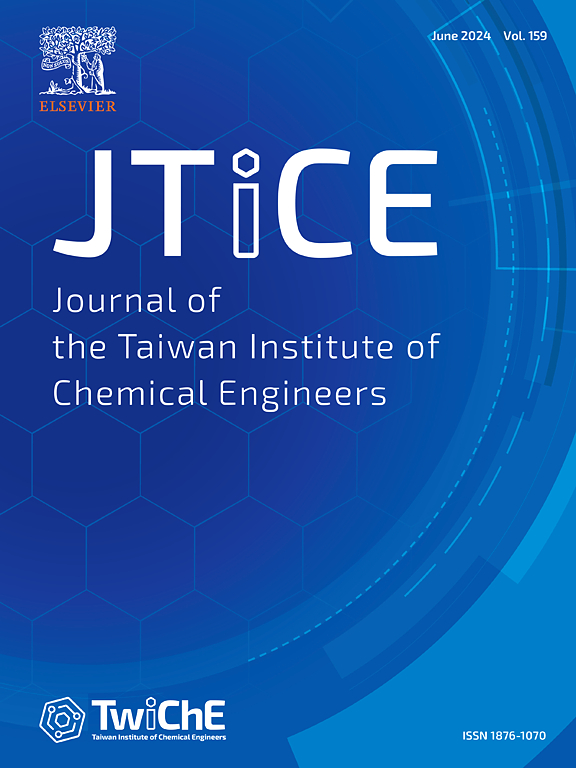Effect of polydimethylsiloxane content on the electrothermal performance and tensile strength of laser induced graphene films: Experimental and theoretical
IF 5.5
3区 工程技术
Q1 ENGINEERING, CHEMICAL
Journal of the Taiwan Institute of Chemical Engineers
Pub Date : 2024-10-25
DOI:10.1016/j.jtice.2024.105803
引用次数: 0
Abstract
Background
Since its discovery in 2014, laser induced graphene (LIG) has gained a lot of interest from research institutions and the industry as a result of its single-step fabrication process and tailorable properties. Nonetheless, LIG's brittle nature makes it susceptible to any mechanical disturbances thus shearing off from the polyimide (PI) sheet surface. This limits its applicability in electrothermal heating and other applications requiring high flexibility. Therefore, there is a need to enhance LIG's robustness on the precursor surface.
Methods
To overcome this, LIG films were fabricated from PI using a 10.6 µm CO2 laser machine and polydimethylsiloxane (PDMS) contents were infused into the LIG structure by spin coating to form LIG/PDMS films. Furthermore, the adhesion strength of LIG/PDMS films was further improved by making micro scratches on the substrate surface by pressing the PI sheets in between the jaws of a Universal Testing Machine (UTM). The joule heating of LIG and LIG/PDMS heaters was evaluated before, during, and after mechanical testing. Theoretical models (heat balance and Ansys Finite Element, FE) were also performed to validate experimental results.
Significant findings
At an input DC voltage of 8 V, the LIG/PDMS with 50 μL PDMS and LIG heaters generated saturation temperatures of 250 and 308.86 °C, respectively. Much as the saturation temperatures were lower for LIG/PDMS heaters, their mechanical strength was enhanced in comparison with the LIG heaters. LIG/PDMS films could undergo more bending cycles (4800) than LIG films (2400). Additionally, LIG/PDMS film accommodated more stress (⁓ 0.16 Mpa) than LIG film (⁓ 0.04 Mpa) after tensile tests. Interestingly, the LIG/PDMS heater's electrothermal performance was better than that of LIG heater after tension. The heat balance equation and simulation results showed a tight match with experimental generated temperatures, verifying the approach's trustworthiness. Hence, the demonstrated effectiveness and efficiency of LIG-based heaters with high flexibility under various mechanical stresses open new possibilities for diverse electronic applications.

聚二甲基硅氧烷含量对激光诱导石墨烯薄膜电热性能和拉伸强度的影响实验与理论
背景自 2014 年被发现以来,激光诱导石墨烯(LIG)因其一步法制造工艺和可定制的特性而受到研究机构和业界的广泛关注。然而,LIG 的脆性使其容易受到任何机械干扰,从而从聚酰亚胺(PI)片表面剪切下来。这限制了它在电热加热和其他需要高灵活性的应用中的适用性。为了克服这一问题,我们使用 10.6 µm CO2 激光机从 PI 制备了 LIG 薄膜,并通过旋涂将聚二甲基硅氧烷(PDMS)注入 LIG 结构,形成 LIG/PDMS 薄膜。此外,还通过在万能试验机(UTM)的夹钳间按压 PI 片,使其在基底表面产生微小划痕,进一步提高了 LIG/PDMS 薄膜的粘附强度。在机械测试之前、期间和之后,对 LIG 和 LIG/PDMS 加热器的焦耳热进行了评估。重要发现在输入直流电压为 8 V 时,带有 50 μL PDMS 的 LIG/PDMS 和 LIG 加热器产生的饱和温度分别为 250 和 308.86 °C。与 LIG 加热器相比,LIG/PDMS 加热器的饱和温度更低,其机械强度也更高。与 LIG 薄膜(2400 次)相比,LIG/PDMS 薄膜可以经受更多的弯曲循环(4800 次)。此外,在拉伸测试后,LIG/PDMS 薄膜比 LIG 薄膜(⁓ 0.04 Mpa)能承受更大的应力(⁓ 0.16 Mpa)。有趣的是,拉伸后 LIG/PDMS 加热器的电热性能优于 LIG 加热器。热平衡方程和模拟结果显示与实验产生的温度非常吻合,验证了该方法的可靠性。因此,在各种机械应力下具有高柔韧性的 LIG 基加热器的有效性和效率为各种电子应用开辟了新的可能性。
本文章由计算机程序翻译,如有差异,请以英文原文为准。
求助全文
约1分钟内获得全文
求助全文
来源期刊
CiteScore
9.10
自引率
14.00%
发文量
362
审稿时长
35 days
期刊介绍:
Journal of the Taiwan Institute of Chemical Engineers (formerly known as Journal of the Chinese Institute of Chemical Engineers) publishes original works, from fundamental principles to practical applications, in the broad field of chemical engineering with special focus on three aspects: Chemical and Biomolecular Science and Technology, Energy and Environmental Science and Technology, and Materials Science and Technology. Authors should choose for their manuscript an appropriate aspect section and a few related classifications when submitting to the journal online.

 求助内容:
求助内容: 应助结果提醒方式:
应助结果提醒方式:


